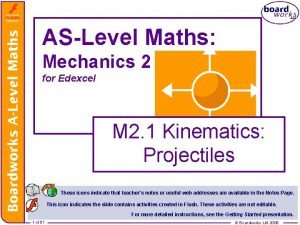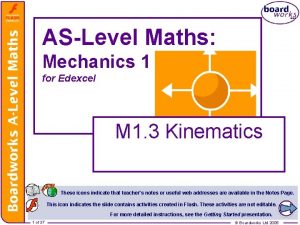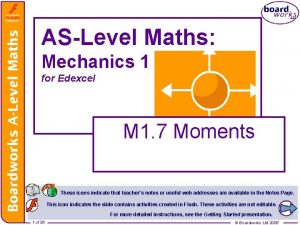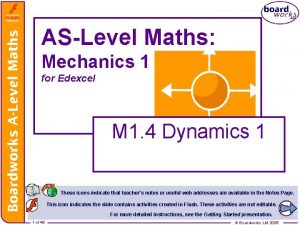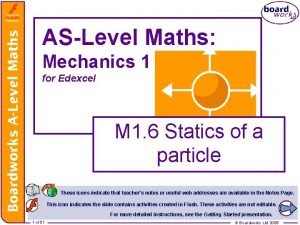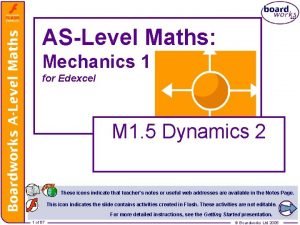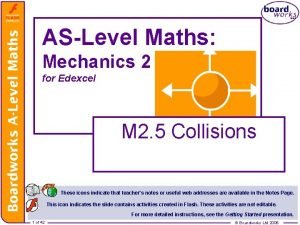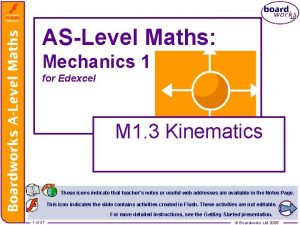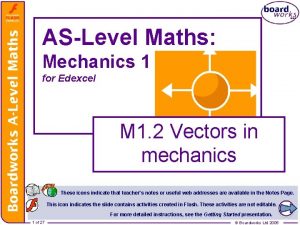ASLevel Maths Mechanics 2 for Edexcel M 2














































- Slides: 46

AS-Level Maths: Mechanics 2 for Edexcel M 2. 4 Work and Energy These icons indicate that teacher’s notes or useful web addresses are available in the Notes Page. This icon indicates the slide contains activities created in Flash. These activities are not editable. For more detailed instructions, see the Getting Started presentation. 1 of 46 © Boardworks Ltd 2006

Energy Contents Work Conservation of energy Work-energy and dissipative forces Power Examination-style questions 2 of 46 © Boardworks Ltd 2006

Mechanical energy Energy is a measure of a particles capacity to do work. Energy is measured in joules or kilojoules, represented by J or k. J. Energy exists in many forms. These include electrical energy, chemical energy, heat energy and light energy. Mechanical energy is energy that a particle has due to either its motion or its position. Mechanical energy is the energy that will be considered in M 2. It comes in two forms – kinetic and potential energy. 3 of 46 © Boardworks Ltd 2006

Kinetic and potential energy Kinetic Energy Kinetic energy is the energy a particle possesses due to its motion. Kinetic Energy is defined as ½mv 2 where m is mass in kg and v is speed in ms-1. Gravitational Potential Energy is the energy a particle possesses due to its position. It is stored energy. Change in Gravitational Potential Energy is defined as mgh, where m is mass in kg, g is acceleration due to gravity and h is the vertical distance travelled in metres. 4 of 46 © Boardworks Ltd 2006

Kinetic energy Find the kinetic energy of the following: a) A particle of mass 0. 5 kg travelling at 8 ms-1 b) A car of mass 900 kg travelling at 15 ms-1 c) A bullet of mass 20 g travelling at 500 ms-1 a) K. E. , in joules, b) K. E. , in joules, c) K. E. , in joules, 5 of 46 = ½ × m × v 2 = ½ × 0. 5 × 82 = 16 = ½ × m × v 2 = ½ × 900 × 152 = 101 250 = ½ × m × v 2 = ½ × 0. 02 × 5002 = 2500 © Boardworks Ltd 2006

Gravitational potential energy Find the gravitational potential energy of the following, stating whether it is a gain or loss in gravitational potential energy: a) A particle of mass 2 kg raised a vertical distance of 8 m b) A lift of mass 500 kg descending 50 m vertically c) A man of mass 80 kg climbing a vertical distance of 75 m. a) G. P. E. , in joules, = m × g × h = 2 × 9. 8 × 8 = 156. 8 This is a gain in G. P. E. b) G. P. E. , in joules, = m × g × h = 500 × 9. 8 × 50 = 245 000 This is a loss of G. P. E. c) G. P. E. , in joules, = m × g × h = 80 × 9. 8 × 75 = 58 800 This is a gain in G. P. E. 6 of 46 © Boardworks Ltd 2006

Energy question 1 Question 1: Find the gain in kinetic energy of a car of mass 800 kg as it accelerates from 10 ms-1 to 25 ms-1. Initial K. E. = ½ × m × v 2 = ½ × 800 × 102 = 40 000 Final K. E. = ½ × m × v 2 = ½ × 800 × 252 = 250 000 Therefore the gain in kinetic energy of the car is 210 000 J. 7 of 46 © Boardworks Ltd 2006

Energy question 2 Question 2: A child of mass 30 kg slides down a slide of length 4 m inclined at an angle of 30° to the horizontal. By modelling the child as a particle and the slide as a smooth inclined plane, find the loss of gravitational potential energy of the child. G. P. E. 4 m 30 g N 30° =m×g×h = 30 × 9. 8 × 4 sin 30° = 588 Therefore the loss in G. P. E. is 588 J. 8 of 46 © Boardworks Ltd 2006

Work Energy Contents Work Conservation of energy Work-energy and dissipative forces Power Examination-style questions 9 of 46 © Boardworks Ltd 2006

Work can be defined as force × distance i. e. , the work done by a constant force is the force (in Newtons) multiplied by the distance moved (in metres) in the direction of the force. If the direction of the force is different to the direction of motion then Work = F × dcos = Fdcos F Direction of motion 10 of 46 © Boardworks Ltd 2006

Work question 1 Question 1: Find the work done by a force of 10 N acting on a particle that moves 3 m in the direction of the force. Work = force × distance = 10 × 3 = 30 Therefore the work done by the force is 30 J. 11 of 46 © Boardworks Ltd 2006

Work question 2 Question 2: A particle of mass 2 kg is pulled 3 m along a smooth horizontal surface by a force of 8 N acting at an angle of 60° to the horizontal. Find the work done by the force. 8 N 2 kg 60 o Direction of motion Work done = Fdcos = 8 × 3 × cos 60° = 12 Therefore work done by the force is 12 J. 12 of 46 © Boardworks Ltd 2006

Work question 3 Question 3: A stone of mass 50 g falls from the top of a cliff of height 75 m. Find the work done by gravity as the stone falls. 0. 05 g N Work done = force × distance = (0. 05 × 9. 8) × 75 = 36. 75 Therefore the work done by gravity is 36. 75 J. 13 of 46 © Boardworks Ltd 2006

Work question 4 Question 4: A particle of mass 5 kg is pulled 8 m up a rough plane inclined at an angle of 60° to the horizontal. The coefficient of friction between the plane and the particle is 0. 3. a) Find the work done against friction. b) Find the work done against gravity. R F 5 g N 60° 14 of 46 © Boardworks Ltd 2006

Work question 4 a) To find the work done against the frictional force it is first necessary to find the frictional force. Resolving perpendicular to the plane: R = 5 gcos 60° = 2. 5 g F = µR = 0. 3 × 2. 5 g = 7. 35 The frictional force is 7. 35 N. The distance travelled in the direction opposite to the frictional force is 8 m. Work done against friction = 7. 35 × 8 = 58. 8 J. 15 of 46 © Boardworks Ltd 2006

Work question 4 b) To find the work done against gravity it is necessary to calculate the vertical distance travelled. 8 m h 60° sin 60° = h ÷ 8 h = 8 sin 60° Work done against gravity = 5 g × 8 sin 60° = 339 J (3 s. f. ) 16 of 46 © Boardworks Ltd 2006

Conservation of energy Energy Contents Work Conservation of energy Work-energy and dissipative forces Power Examination-style questions 17 of 46 © Boardworks Ltd 2006

Conservation of energy The total mechanical energy of a particle remains constant if the only force acting on the particle is gravity. The total mechanical energy of a particle is the sum of any kinetic energy and any potential energy. Hence, for a particle on which the only force acting is gravity, Initial K. E. + Initial P. E. = Final K. E. + Final P. E. Therefore Loss in K. E. = Gain in P. E. and Gain in K. E. = Loss in P. E. 18 of 46 © Boardworks Ltd 2006

Conservation question 1 Question 1: A particle of mass 5 kg slides down a smooth slope inclined at an angle of 30° to the horizontal. Given that the particle starts from rest, find the distance travelled along the slope when the particle has reached a speed of 4. 9 ms-1. Since the only force acting on the particle is gravity, energy is conserved. 5 g 30° Initial K. E. = 0 (the particle is at rest) Final K. E. = ½ × 5 × 4. 92 = 60. 025 Gain in K. E. = 60. 025 J Loss in G. P. E. = 60. 025 J 19 of 46 © Boardworks Ltd 2006

Conservation question 1 Change in G. P. E. = 5 × 9. 8 × h = 60. 025 d 1. 225 m 30° Therefore the distance moved along the slope is 2. 45 m. 20 of 46 © Boardworks Ltd 2006

Conservation question 2 Question 2: A particle of mass 2 kg is projected up a rough plane inclined at an angle of 45° to the horizontal. The coefficient of friction between the particle and the plane is 0. 15. If the particle travels 5 m up the plane before coming to rest, find the speed with which the particle was projected. Since the only force acting on the particle is gravity, energy is conserved. To calculate the gain in G. P. E. we need to calculate the vertical height gained. h = 5 sin 45° 5 m 45° 21 of 46 h Therefore the vertical distance travelled is 3. 54 m (3 s. f. ). © Boardworks Ltd 2006

Conservation question 2 Gain in G. P. E. = mgh = 2 × 9. 8 × 5 sin 45 2 g = 69. 3 (3 s. f. ) 45° As energy is conserved, gain in G. P. E. = loss in K. E. Initial K. E. = ½ × 2 × v 2 Final K. E. = 0 (particle comes to rest) Loss in K. E. ½× 2× v 2 = 69. 3 Gain in G. P. E. v = 8. 32 (3 s. f. ) Therefore the particle is projected up the plane with a speed of 8. 32 ms-1. 22 of 46 © Boardworks Ltd 2006

Work-energy and dissipative forces Energy Contents Work Conservation of energy Work-energy and dissipative forces Power Examination-style questions 23 of 46 © Boardworks Ltd 2006

Work-energy principle The relationship between work and energy is a simple one: Work Done = Change in Kinetic Energy This can be seen from the following application of Newton’s Second Law. A particle of mass m kg is moved a distance of d m horizontally by a constant horizontal force F N. Let the initial speed be u ms-1 and the final speed be v ms-1. 24 of 46 © Boardworks Ltd 2006

Work-energy principle By Newton’s Second Law: F = ma a = F/m Since the force is assumed constant, the acceleration can also be assumed constant. Using v 2 = u 2 + 2 as v 2 = u 2 + 2 × F/m × d v 2 = u 2 + Remember: s = distance u = initial velocity v = final velocity ½mv 2 = ½mu 2 + Fd This gives 25 of 46 Fd = ½mv 2 – ½mu 2 © Boardworks Ltd 2006

Work-energy question 1 Question 1: A particle of mass 3 kg is pulled 6 m by a horizontal force of 10 N across a smooth horizontal surface. If the particle started from rest, find its speed when it has travelled 6 m. Work done = Fd = 10 × 6 = 60 Direction of motion Fd = ½mv 2 – ½mu 2 Work done = ½mv 2 – ½mu 2 = 60 3 kg 10 N ½ × 3 × v 2 – 0 = 60 1. 5 v 2 = 60 v = 6. 32 (3 s. f. ) Therefore the speed of the particle when it has travelled 6 m is 6. 32 ms-1. 26 of 46 © Boardworks Ltd 2006

Work-energy question 2 Question 2: Find the horizontal force that causes a particle of mass 2. 5 kg to increase speed from 2 ms-1 to 5 ms-1 over a distance of 10 m on a smooth horizontal surface. Work done = change in kinetic energy Initial K. E. = ½ × 2. 5 × 22 = 5 Final K. E. = ½ × 2. 5 × 52 = 31. 25 Change in kinetic energy = 26. 25 Work done = Fd = 10 F = 26. 25 F = 2. 625 Therefore the required force is 2. 625 N. 27 of 46 © Boardworks Ltd 2006

Work and dissipative forces A dissipative force is a force which causes a particle to lose energy. This means that the principle of conservation no longer applies, as the total mechanical energy of the particle is not constant. Friction and air resistance are examples of dissipative forces. Work done against a dissipative force is equal to the loss of the total mechanical energy of the system. 28 of 46 © Boardworks Ltd 2006

Work and dissipative forces Example: A particle of mass 3 kg is moving down a rough slope inclined at an angle of 30° to the horizontal. The particle passes a point A at 3 ms-1 and a point B 2 m down the slope at 4 ms-1. Calculate the work done against friction. Gain in K. E. = ½ × 3 × 42 – ½ × 32 = 10. 5 J sin 30° = h ÷ 2 h = 2 sin 30° = 1 2 m 30° Loss in G. P. E. = 3 × g × 1 = 29. 4 J Loss of energy = 29. 4 – 10. 5 = 18. 9 Work done against friction = 18. 9 J 29 of 46 © Boardworks Ltd 2006 h

Power Energy Contents Work Conservation of energy Work-energy and dissipative forces Power Examination-style questions 30 of 46 © Boardworks Ltd 2006

Power is defined as the rate of doing work, with respect to time. Power is calculated by: The S. I. unit of power is the watt, which is a rate of work of 1 joule per second. The watt is a relatively small unit. You will more commonly meet the larger unit, the kilowatt. 1 kilowatt (abbreviated to 1 k. W) = 1000 watts = 1000 joules per second 31 of 46 © Boardworks Ltd 2006

Power Consider a force F acting for a small time interval t over a small distance d. Work done = F × d So, Power = = Fv So, the power of an engine or machine moving at a speed v subject to a driving force F is Fv. 32 of 46 © Boardworks Ltd 2006

Power question 1 Question 1: A car exerts a driving force of 1500 N. If the car is travelling at a constant speed of 35 ms-1, calculate the power of the engine. Power, in watts = Fv = 1500 × 35 = 52 500 Therefore the power produced by the car engine is 52. 5 k. W. 33 of 46 © Boardworks Ltd 2006

Power question 2 Question 2: The engine of a car is generating power of 18 k. W. Find the driving force produced when the car is travelling at a speed of: a) 12 ms-1 b) 20 ms-1 c) 30 ms-1 Power = Force × Velocity So, a) Force produced = 18 000 ÷ 12 = 1500 N b) b) Force produced = 18 000 ÷ 20 = 900 N c) Force produced = 18 000 ÷ 30 = 600 N 34 of 46 © Boardworks Ltd 2006

Power question 3 Question 3: A cyclist is travelling along a horizontal road at a constant speed of 7 ms-1. If the cyclist experiences a total resistance to motion of 20 N, find the power produced by the cyclist. Since the speed is constant there is no acceleration. Therefore, driving force = resistance force. Driving force = 20 N Velocity = 7 ms-1 Power = 20 × 7 = 140 W 35 of 46 © Boardworks Ltd 2006

Examination-style questions Energy Contents Work Conservation of energy Work-energy and dissipative forces Power Examination-style questions 36 of 46 © Boardworks Ltd 2006

Exam question 1 Examination-style question 1: A car of mass 1000 kg moves along a straight, horizontal road. The car engine is working at a constant rate of 45 k. W and the total resistance to the motion of the car is 500 N. a) Find the acceleration of the car when its speed is 15 ms-1. The car comes to a hill which is inclined at an angle of to the horizontal, where sin = 0. 1. The resistance to the motion of the car is unchanged. b) Find the maximum speed of the car up the hill when it is working at a rate of 45 k. W. 37 of 46 © Boardworks Ltd 2006

Exam question 1 a) To calculate the acceleration it is first necessary to calculate the driving force. Power = Force × Velocity a 500 N D 1000 So, Applying Newton’s Second Law, F = ma 3000 – 500 = 1000 a = 2500 a = 2. 5 38 of 46 Therefore the acceleration of the car when it is travelling at 15 ms-1 is 2. 5 ms-2. © Boardworks Ltd 2006

Exam question 1 b) Before calculating the maximum speed of the car it is first necessary to calculate the driving force. R 500 N D 1000 g Applying Newton’s Second Law up the slope, D – 500 – 1000 gsin = 0 D = 500 + 1000 g × 0. 1 = 1480 The driving force of the car is 1480 N. Power = Force × Velocity The maximum speed of the car is 30. 4 ms-1. 39 of 46 © Boardworks Ltd 2006

Exam question 2 Examination-style question 2: A stone of mass 0. 5 kg is sliding down a rough plane inclined at an angle of 15° to the horizontal. The stone passes a point A with a speed of 10 ms-1 and a point B with a speed of 6 ms-1. a) Find the loss of mechanical energy of the stone as it moves from point A to point B. b) Calculate the coefficient of friction between the stone and the plane. 40 of 46 © Boardworks Ltd 2006

Exam question 2 a) Loss of energy of the stone = loss of K. E. + loss of G. P. E. Initial K. E. = ½ × 0. 5 × 102 Final K. E. = ½ × 0. 5 × 62 Loss of K. E. = 25 – 9 = 16 J 10 15° h h = 10 sin 15° Loss of G. P. E. = 0. 5 × 9. 8 × 10 sin 15° = 12. 7 (3 s. f. ) 16 + 12. 7 = 28. 7 Therefore the loss of energy of the stone is 28. 7 J. 41 of 46 © Boardworks Ltd 2006

Exam question 2 b) To calculate the coefficient of friction, it is necessary to calculate both the normal contact force and the frictional force. R = 0. 5 gcos 15° = 4. 73 (3 s. f. ) R 15° F 0. 5 g Loss of energy of the stone found in part a) is equal to the work done against friction. The work done against friction over a distance of 10 m is 28. 7 J. Work done = force × distance force = 28. 7 ÷ 10 = 2. 87 the coefficient of friction is 0. 61. 42 of 46 © Boardworks Ltd 2006

Exam question 3 Examination-style question 3: A parcel of mass 30 kg is hauled up a slope inclined at an angle of 20° to the horizontal. The parcel is hauled by means of a constant force of 300 N at an angle of 30° to the line of greatest slope of the plane. The acceleration of the parcel up the plane is 0. 1 ms-2 and the total resistance to motion is RN. a) Find the work done by the force in hauling the parcel, from rest, 10 m up the slope. b) By considering work and energy, find the value of R. 43 of 46 © Boardworks Ltd 2006

Exam question 3 a) Work done = force × distance Since the force acts at an angle of 30° to the slope, the component of force acting along the slope must be calculated. 300 N 30° c c = 300 cos 30 o = 260 (3 s. f) Work done = 260 × 10 = 2600 So, work done by the force is 2600 J. 44 of 46 © Boardworks Ltd 2006

Exam question 3 b) so, h = 10 sin 20° 10 h 20° Gain in G. P. E. = 30 × 9. 8 × 10 sin 20 o = 1006 (4 s. f) To find gain in K. E. it is necessary to find the speed of the parcel after it has travelled 10 m. v 2 = u 2 + 2 as = 0 + 2 × 0. 1 × 10 = 2 v = 1. 41 ms-1 (3 s. f. ) Gain in K. E. = ½ × 30 × 2 = 30 45 of 46 © Boardworks Ltd 2006

Exam question 3 1006 + 30 = 1036 Therefore the increase in energy of the system is 1036 J (4 s. f). The difference between the work done by the force acting up the slope and the gain in energy of the system is 2600 – 1036 = 1564 J. This is the work done by the resistance force. Work done = force × distance R = 1564 ÷ 10 = 156. 4 N 46 of 46 © Boardworks Ltd 2006
 Edexcel a level maths hypothesis testing
Edexcel a level maths hypothesis testing Electronics chart
Electronics chart Påbyggnader för flakfordon
Påbyggnader för flakfordon Tack för att ni lyssnade
Tack för att ni lyssnade Egg för emanuel
Egg för emanuel Atmosfr
Atmosfr Rutin för avvikelsehantering
Rutin för avvikelsehantering Meios steg för steg
Meios steg för steg Byggprocessen steg för steg
Byggprocessen steg för steg Personlig tidbok fylla i
Personlig tidbok fylla i Myndigheten för delaktighet
Myndigheten för delaktighet Presentera för publik crossboss
Presentera för publik crossboss Rbk mätning
Rbk mätning Fspos
Fspos Var 1721 för stormaktssverige
Var 1721 för stormaktssverige Tack för att ni har lyssnat
Tack för att ni har lyssnat Tobinskatten för och nackdelar
Tobinskatten för och nackdelar Tack för att ni lyssnade bild
Tack för att ni lyssnade bild Hur ser ett referat ut
Hur ser ett referat ut Fimbrietratt
Fimbrietratt Varför kallas perioden 1918-1939 för mellankrigstiden?
Varför kallas perioden 1918-1939 för mellankrigstiden? Punkthöjd karttecken
Punkthöjd karttecken Kraft per area
Kraft per area Större än
Större än Elektronik för barn
Elektronik för barn Borra hål för knoppar
Borra hål för knoppar Sura för anatom
Sura för anatom Smärtskolan kunskap för livet
Smärtskolan kunskap för livet Bris för vuxna
Bris för vuxna Bra mat för unga idrottare
Bra mat för unga idrottare Novell typiska drag
Novell typiska drag Trög för kemist
Trög för kemist Teckenspråk minoritetsspråk argument
Teckenspråk minoritetsspråk argument Indikation för kejsarsnitt på moderns önskan
Indikation för kejsarsnitt på moderns önskan För och nackdelar med firo
För och nackdelar med firo Toppslätskivling dos
Toppslätskivling dos Rita perspektiv
Rita perspektiv Mall debattartikel
Mall debattartikel Redogör för vad psykologi är
Redogör för vad psykologi är Lek med geometriska former
Lek med geometriska former Bästa kameran för astrofoto
Bästa kameran för astrofoto En lathund för arbete med kontinuitetshantering
En lathund för arbete med kontinuitetshantering Etik och ledarskap etisk kod för chefer
Etik och ledarskap etisk kod för chefer Publik sektor
Publik sektor Dikter om vänskap
Dikter om vänskap Kvinnlig mantel i antikens rom
Kvinnlig mantel i antikens rom Vilken grundregel finns det för tronföljden i sverige?
Vilken grundregel finns det för tronföljden i sverige?
















































